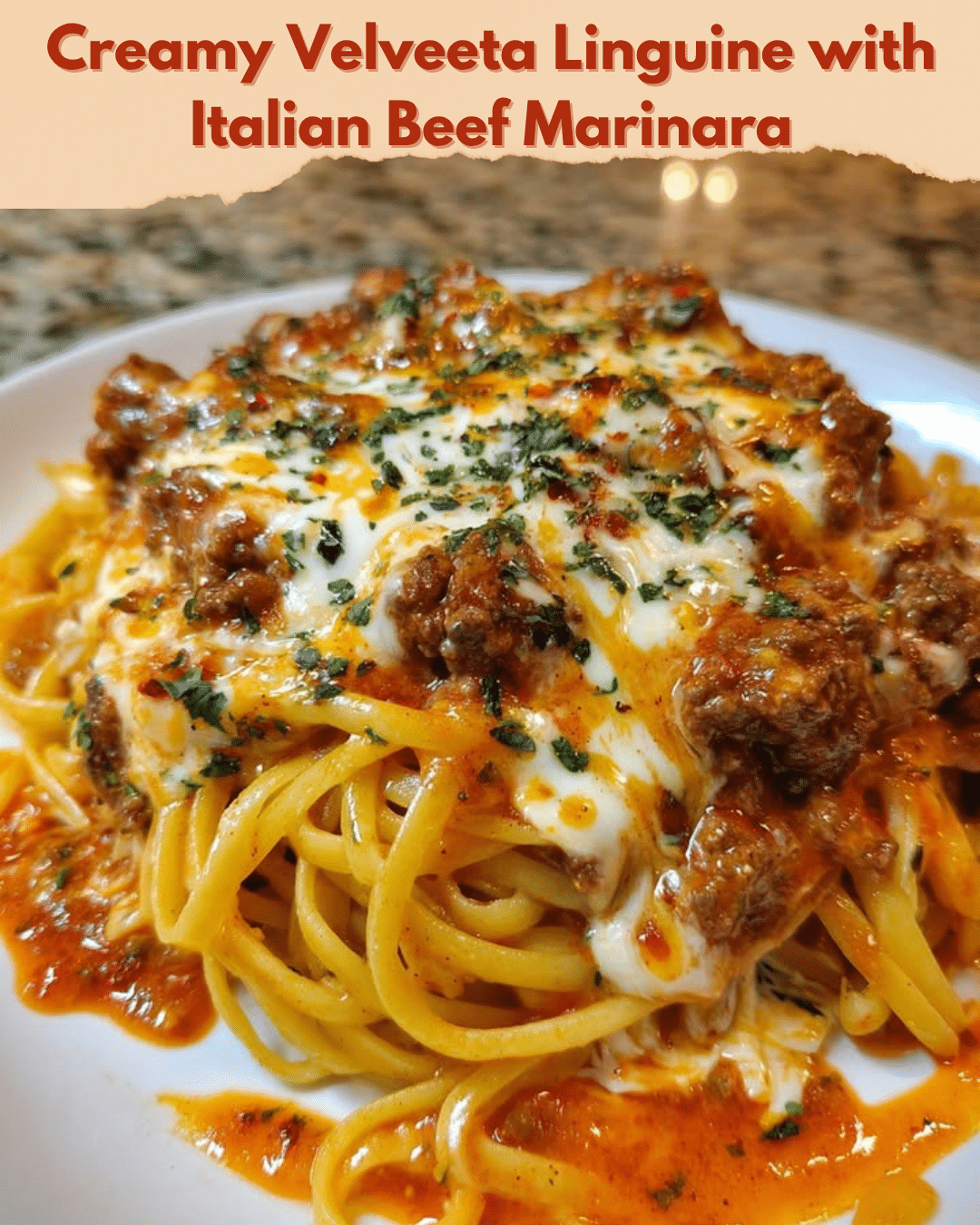Creamy Velveeta Linguine with Italian Beef Marinara: A Comforting Classic
Creamy Velveeta Linguine with Italian Beef Marinara is a delightful fusion of rich flavors and textures. Imagine twirling creamy linguine coated in the velvety cheese sauce while savoring the robust marinara, kissed with perfectly seasoned Italian beef. It’s a dish that promises warmth, satisfaction, and a touch of indulgence with every bite. Whether a cozy family dinner or an intimate gathering with friends, the lively interplay of flavors and the comforting consistency will charm your taste buds.
Combining the smooth and creamy nature of Velveeta with the hearty succulence of Italian beef offers a complete dining experience. The marinated beef texure melds wonderfully with freshly cooked linguine, making each forkful an exploration of savory depth and creamy elegance. The enchanting aroma of this dish as it simmers fills the room with an inviting essence of comfort and home-cooked delight. The eye-catching combination of golden cheese sauce and vibrant, rich red marinara ensures a feast for the eyes as much as the palate.
Quick Recipe Highlights
- Flavor Profile: An enticing blend of creamy, cheesy richness married with the deep, hearty umami of Italian beef.
- Texture: Silky linguine intertwined with tender beef morsels, all enveloped in a creamy sauce that doesn’t overpower.
- Aroma: A tantalizing aroma of simmering marinara and melty Velveeta, igniting anticipation.
- Visual Appeal: The vibrant interplay of creamy oranges and deep marinaras promises visual and gustatory delights.
- Skill Level Needed: Perfect for all skill levels with straightforward steps ensuring culinary success.
- Special Equipment: A large pot, skillet, and colander are all you need, keeping it simple and hassle-free.
Recipe Overview
- Difficulty Level: Designed for even the most novice cooks while exciting enough for seasoned chefs, blending familiar ingredients in surprising ways.
- Category: Comfort food at its best, ideal for a hearty dinner or a special weekend feast.
- Cuisine: Rooted in Italian-American tradition, it’s a fusion of classic Italian flavors with modern American twists.
- Cost: The recipe is budget-friendly, using common household ingredients without sacrificing luxury or taste.
- Season: A dish for all seasons, its warmth in winter and satisfying lightness in warmer months make it truly versatile.
- Occasion: Suitable for both everyday dinners and festive gatherings, the perfect blend of ease and elegance.
Why You’ll Love This Recipe
This Creamy Velveeta Linguine with Italian Beef Marinara delights with its impeccable blending of taste and texture. Each bite carries a rich, cheesy melody, perfectly countered by the robust tang of beefy marinara. You will savor the way the creamy linguine mingles with the succulent beef, offering a balanced taste that satisfies without overwhelming. Designed for weekday convenience, this recipe boasts a quick prep and cook time, making it an ideal choice for busy weeknights. Its reliance on readily available and affordable ingredients ensures minimal fuss in the kitchen!
Nutritionally, this dish provides a good balance of essential macronutrients with carbohydrates from linguine, protein from beef, and fats from Velveeta, offering energy and satisfaction. Socially, it brings warmth, camaraderie, and comfort to the table, perfect for shared meals and creating cherished memories over delicious food. It’s a cost-effective and approachable recipe for everything from casual evenings to intimate dinner parties. Its ingredients, easy to find and inexpensive, make it an ideal option for both planned meals and impromptu gatherings.
Historical Background and Cultural Significance
The humble pasta has been a staple in Italian cuisine for centuries, its rich history blending comfort with artistic expression in each strand. Italian beef, with roots in Chicago’s bustling meat markets, brings a robust heartiness that, when marinated, complements pasta’s simplicity. The fusion in this recipe reflects the age-old tradition of blending robust flavors for richness and depth, echoing the cultural evolution from traditional Italian fare to distinctly American comfort classics.
Through time, adaptations like Velveeta, a uniquely American creation, have furthered this evolution, seamlessly introducing cheesiness to traditional marinara. This adaptation serves regional variations effortlessly, from urban twists echoing metropolitan dining scenes to rustic renditions found in comfortable home kitchens. Such culinary fusion highlights both the versatility and cultural blending in contemporary cuisine, linking past influences to present tastes in every forkful.
Ingredient Deep Dive
Linguine, with its flat, ribbon-like strands, is an Italian pasta delight, historically regarded for its pairing with sauces that demand a robust companionship. Its ability to uphold ample sauce makes it a beloved choice across Italian tables, capturing the rich textures and nuanced flavors afforded by both light coatings and heavier accompaniments. This versatility undeniably contributes to the dish’s overall harmony.
Velveeta Cheese, pioneered as a means of reducing cheese waste, revolutionizes culinary recipes with its smooth, easy-melting factor, creating creamy contexts without effort. Nutritionally, Velveeta enriches dishes with a straightforward, satisfying umami, its texture smoothly complimenting aged cheeses without complication. Its accessibility grounds home cooking in comfort without time-consumption, emphasizing ease but not compromise.
Common Mistakes to Avoid
- Overcooking the linguine can result in a mushy texture. Be sure to cook it al dente to maintain the desired bite.
- Not draining the pasta well could water down your sauce. Shake the colander slightly to remove excess water.
- Add Velveeta gradually to avoid a clumping texture. It should slowly integrate into the stew for perfect creaminess.
- Under-seasoning the beef hinders complexity. Taste and adjust seasoning before combining with the sauce.
- Ignoring the importance of resting. Let the sauce meld while off the heat for intensified flavor.
- Using very lean beef may result in a dry mouthfeel; balance fat content for juicy, flavorful results.
- Avoid skipping oil during frying. It prevents beef from sticking and fosters crucial flavor development.
- Underestimating heat control in simmering can lead to burnt sauce. Stir frequently and maintain medium heat.
Essential Techniques
Perfectly cooked pasta is foundational, requiring attention to water salinity and timing. Salt enhances flavor absorption during boiling, while precise timing ensures the linguine maintains its robust structure needed to support the creamy sauce and beef. Watching for translucent edges and a firm central bite is key, nudging al dente completion with pinpoint care.
Slowly integrating Velveeta involves gentle melting over controlled heat, supporting its natural smooth infusion into sauces. This technique removes potential grit or clumping, unlocking the cheese’s creamy potential. Observing gradual melting cues, with constant whisking, ensures uniform dispersal and enhances the dish’s mouth-filling body without altering its intended taste signature.
Pro Tips for Perfect Creamy Velveeta Linguine with Italian Beef Marinara
Building flavor through layers involves sautéing aromatic vegetables before beef for a foundational base. Flavor should be added with every step, from seasoning pasta water to finishing the sauce. Balance rich cheese with bright, acidic tomato notes; find harmony between richness and piquant freshness. Resting the dish briefly enables full flavor blending, a quiet period reinforcing the richness absorbed by cooling linguine.
Using a Dutch oven for its heat retention delivers even, steady cooking. Stir in a small ladle of pasta water to emulsify when blending pasta and sauce; this step binds the dish across ingredients seamlessly. Experiment with fresh herbs like basil or thyme in manageable quantities, brightening the dish. Remember, less is more when aiming for subtle, refreshing accents without overwhelming the completed profile.
Variations and Adaptations
Regional influences guide variations, such as swapping marinara for pesto in summer adaptations, aligning seasonal produce and preferences. Methodical additions can mirror dietary constraints, introducing gluten-free linguine or plant-based proteins in vegan variations, keeping dietary concerns forefront without detracting from loved comfort essentials.
Spice intensification might include crushed red pepper or spicy sausage alternatives, while experimental adaptations could explore additional cheese blends or nutty parmesans for a gourmet twist. Balancing textures through garnishing with nuts or seeds fosters added layers, contrasted with simple plate arrangements emphasizing crowning quality over ostentatious inclusion.
Serving and Presentation Guide
Effective visual presentation finds beauty in simplicity, emphasizing strategic placement. Fresh herb sprigs, ground black pepper, and drizzles of olive oil highlight freshness against warmer tones. Portions arranged within shallow bowls or broad plates balance traditional serving simplicity with clean, modern aesthetics. Platings maintain warmth and texture balance, encouraging natural aromas that accompany welcoming indulgence over typical pasta bowls.
Pair servings with crusty bread or simple side salads to streamline accompaniments without complicating the main attraction, ensuring that no components detract from the dish’s inherent richness and indulgent nature. Offer considered proportioning, emphasizing enough to leave diners full but curious for assembled seconds.
Wine and Beverage Pairing
A versatile red wine pairing can complement the dish’s richness without overpowering. Look for medium-bodied reds like Chianti or Montepulciano, providing a perfect blend of acidity and tannins to balance the creamy and tangy notes in the sauce. Non-alcoholic alternatives such as sparkling water with citrus slices can offer a palate-cleansing effect. Iced tea is another refreshing companion, bridging warmth and richness with a complementary chilly texture.
Seasonally, chilled beverages in warmer months contrast favorably against the dish’s natural indulgence, while in colder times, pairing with spiced wines accentuates its comforting potential and adds a festive atmosphere for suitable occasions.
Storage and Shelf Life
Stored properly in airtight containers, this dish offers reliable shelf life, lasting up to three days refrigerated. Prevent moisture loss by employing cling wrap over container tops before sealing for an added freshness barrier. Watch for changes in texture. Discard upon sour odors or unexpected textual separation. Reheat gently on the stove, adding a dash of milk or broth to restore creaminess when needed.
Stirring occasionally promotes even distribution, ensuring all components revive evenly. For extended preservation, freezing is viable—cool the dish thoroughly before portion-sealing—allowing up to a month’s storage before use. Defrost overnight in a refrigerator for best reheating results, maintaining safety guidelines throughout the process.
Make Ahead Strategies
Prepare sauces and cook beef up to two days in advance, storing separately to maintain distinct flavors over time. Reheat to steaming hot just before serving, melting cheese freshly when ready for service. Keep components segregated; linguine should remain undressed until final combination. Apply oil to preserve its texture if necessary, preparing for later warmth and melding with sauce only during last stages of assembly.
Remember to refresh forgotten elements with fresh cheeses over reheating for itch pristine savoring immediately upon arrival to table or plate. This foresight requires anticipation of event dynamics and enables stress-free serving, contributing seamless convenience within more elaborate preparations.
Scaling Instructions
When scaling the recipe, consider equipment size to maintain consistency. Doubling volumes demands larger pots or sequential batch cooking to preserve contact and even heating. Adjust timings minimally; increased thickening times often occur due to increased volume, while seasoning requires tasting for accurate proportionality.
If halving, reduce component separations carefully; excess liquid may linger without attentive gauging, leading to imbalance or diluted flavors. Emphasize accuracy in measuring and taste-testing, recalibrating consistently throughout the preparation for refined representations within altered proportions.
Nutritional Deep Dive
A balanced macro breakdown promotes energy and satisfaction, combining carbohydrates for quick accessibility, fats for sustained fullness, and proteins for muscle-building support, vital in well-rounded dietary applications. Rich in calcium and robust mineral offerings, this dish caters to both dietary needs and sensory hunger without extremes.
The versatility of the recipe permits mindful adjustments to suit varied lifestyles without compromising completion; subtle ingredient swaps ensure maintained nutritional integrity, promoting balancing serums over calorie abundance. Discerning portion control complements weight-aware choices, offering indulgence minus overindulgence or neglect.
Dietary Adaptations
Vegan adaptations might engage plant-based cheeses and proteins, substituting directly while reinforcing flavors with enhanced herbs to compensate potential taste loss through omission. Gluten-free pasta ensures accessibility without allergen hindrance. Keto choices employ spiralized zucchini instead of pasta, prioritizing grain avoidance within carbohydrate prohibition.
Customizable options allow natural dietary inclusivity, supporting selective feedings across various needs, ensuring hearty satisfaction nevertheless. Embrace personalization and innovation through ingredient familiarity, respecting foundational comfort food sentiment allying with metabolic demands.
Troubleshooting Guide
Troubleshooting challenges are surmountable, targeting known obstacles with responsive solutions. If creamy consistency eludes, analyze Velveeta incorporation speed and cheese choice, critical variables influencing final silkiness. Address flavor balance through adjunctive ingredients or proportional recalibration, harmonizing potential salt or acid excess.
Texture difficulties often correlate to pasta mishandling or prolonged sauce exposure. Sequence interventions strategically, sticking closely to testing and tasting regimens, evaluating ongoing iterations with a preference for transformative precision. Thoughtful adjustments reflect supportive culinary philosophy, valuing adaptability and success uniformly across sessions.
Recipe Success Stories
Community engagement breathes life and innovation into the dish. Stories abound with inspired variations, enhancing traditional restrictions or extending unique traits. Photographic styling tips differ among participants, embracing simplicity with heartfelt resilience, leveraging light and composition in presenting beguiling structures.
Readers express success in adaptations shared enthusiastically, creating unique pathways to develop underlying themes or embedding playful modernity over anticipated reiterations. Visible dialogues forge collective spieces where knowledge and conceptions intertwine, manifested through expressed preferences and heartfelt endorsements.
Frequently Asked Questions
What can I substitute for Velveeta? Use any well-melting cheese like cheddar or gouda for similar texture; adjust seasoning accordingly to maintain balance.
How do I store leftovers? Refrigerate in airtight containers for up to three days, ensuring proper humidity barriers via versatile wrap mechanisms.
Can I make this dish gluten-free? Certainly, substitute with your favorite gluten-free pasta and verify ingredient labels to ensure adherence to dietary needs.
What if I don’t have Italian beef? Substitute with regular ground beef, seasoned with Italian herbs, or consider turkey for a lighter option.
Is it possible to freeze the dish? Yes, separate components before freezing for intact preservation; reheat with care to restore flavor authenticity.
How can I avoid clumping the cheese? Gradually introduce Velveeta on low heat while stirring; managing temperature prevents premature aggregation.
Can I use another cheese? Besides cheddar, Monterey Jack or a creamy blue cheese can provide delightful results with similar incorporation techniques.
Which pasta works best? Although linguine harmonizes excellently, feel free to explore fettuccine or penne for a textural twist suiting personal preferences.
What if my sauce is too watery? Simmer longer without a lid to reduce excess liquid. Introduce extra cheese gradually to recover sauce consistency as needed.
How to boost the dish’s flavor? Amplify flavors via added spices or herbs, using basil or rosemary for a renewed taste while retaining cheese’s creamy foundation.
Does the dish retain reheated texture? For vibrant texture upon reheat, moderate moisture retention is key. Consider newly melted cheese integrations periodically to invoke appeal.
Additional Resources
Explore complementary recipes, including creamy risottos, enhancing Italian repertoire with varied starch bases or soupy stews accentuating cozy ambiance. Technique guides across trusted platforms detail pasta essentials, ensuring emphasis on achieving that perfect al dente. Resource guides explore regional cheeses across global groceries, uncovering inspiring combinations reflective of dynamic culinary discussions.
Equipment checklists adaptively match technique proficiency with accessible tools and investments. Seasonal roundups identify prime ingredients respecting natural cycles, ensuring nourished engagement with contemporary seasonal bounty. These community offerings affirm open exchange, supporting thriving guide repositories within expanding gastronomic vocabulary.
Print
Creamy Velveeta Linguine with Italian Beef Marinara
Description
A delightful blend of creamy Velveeta cheese and rich Italian beef marinara sauce, served over tender linguine pasta.
Ingredients
For the Crust:
- 8 oz linguine pasta
- 1 lb ground beef
- 1 cup marinara sauce
- 1 cup Velveeta cheese, cubed
- 1 teaspoon Italian seasoning
Instructions
1. Prepare the Crust:
- Cook linguine pasta according to package instructions. Drain and set aside.
- In a large skillet, brown the ground beef over medium heat until fully cooked. Drain excess fat.
- Add marinara sauce and Velveeta cheese to the skillet with the beef. Stir until the cheese is melted and the mixture is smooth. Add Italian seasoning and mix well.
- Combine the cooked linguine with the cheese and beef marinara sauce. Toss to coat the pasta thoroughly.
- Serve hot and enjoy.
Notes
You can customize the seasonings to taste.





